To the Xinsheng elementary school students:
There’s no end for learning. Always remember to “learn from books, people and things”
Best wishes and regards from Professor Lin
|
| Starry Sky and Follow-ups>.Caring and Sharing.Reflections and Feedbacks.Interview Planning |
【Starry Sky and Follow-ups】Interview Planning:The Interview
|
 Cultural literacy is like the DNA of design. Though somewhat hidden, it is the deciding factor of Cultural literacy is like the DNA of design. Though somewhat hidden, it is the deciding factor of
whether the quality of design could be manifested or not. |
|
In mid December of 2012, with the guidance of three teachers and six parents, our design team “The Elves” visited Professor Lin in National Taiwan Normal University. The office of Professor Lin is located at 5 Alley, Qingtian Street. He asked National Taiwan Normal University to arrange a meeting room to welcome us. The university also prepared many of his work so that Professor Lin could explain to and share with us. First of all, our team presented Professor Lin with a thank-you card that was signed by all of us. Professor Lin welcomed us with great hospitality. Because everyone was well prepared, we followed our schedule and proceed with the interview. Professor Lin was very friendly, clear and humorous when answering our questions. He was also very informative when giving explanation. We learned a lot from him. Our parents also reminded us to record the interview completely. Finally, after our teachers expressed our thanks to Professor Lin for his time, we finished the interview task successfully.
| 1. |
Are there any differences in ideals and methods between the design of enterprise and the design of art? In addition, are there any differences between designing a CI for a business owner and for a promotion of an event? |
| A: |
When designing a CI for a business, we must take the markets, consumers and competitors into consideration. In addition, the biggest difference between designing a CI for a business owner and for a promotion of an event is for how long the design will be used. Generally speaking, to design the CI for a company, an enterprise, an organization or a lone term event (for example, the Olympics Games), we need to think about how the CI could be sustainable used. The CI needs to be simple but able to represent the product, service, ideal and culture of the company. For instance, the CI of Olympics Games, which are five interlocking rings, has been used for more than hundreds of years. On the other hand, the design for a commercial or event promotion is different. We only need to consider the period of time that the CI is being used to do the promotion. For the next season or next year, the CI might be changed. |
| |
|
| 2. |
Do you think students in elementary school should start learning design? How could we begin? |
| A: |
I love drawing ever since I was young. I remembered my favorite was drawing comic strips. My second favorite was drawing treasure maps. I felt that the treasure maps must have something to do with design. Because I needed to think about different routes and took in to consideration of which direction was more difficult. Now I feel it is a pity that I could not find the things that I drew when I was little. So I encourage parents to keep the works that their children did. I published a drawing album for my eldest daughter when she got married. I collected all her drawings and writings from the past and made them into an album. Thinking back, I do not feel that one needs the so called talent, but we must work hard in life. |
| |
|
| 3. |
Do you think that one needs gifted talent in doing art design? Could we cultivate that later in life? What are some must have elements, in order to become one of the best design talents? |
| A: |
Personally, I do not think talent is absolutely necessary but we must work hard in life. Even if you have innate advantage, but it will not work when you do not work hard. I will give you an example, there was once a student who won the gold medal in an international art contest when he was in high school. Then he was admitted to Department of Fine Arts, National Taiwan Normal University without taking exams. However, when he graduated, he was not as good as he used to be. Why? Because he felt he was already number one. He felt he was already very good. Though at that time his classmates were not as good as he was. He would not know what would happen in the following four years. As a result, four years later, he realized he still only had the concepts, skills and ideas that he had four years ago. It was a shame. Therefore, you must work and learn hard in order to create excellent design.
Speaking of how to nurture, I believe cultivating a sense of aesthetics is very important. Once a Japanese designer asked me “In Taiwan, how many hours of art education does a child have starting from schooling until going to high school?” I counted roughly. There are two hours in a week in elementary school. When in middle and high school, there is only one hour left. The totally hours of art education in school is only 960 hours. That only takes up to 40 days in 12 years of education! Therefore, the art education in school is definitely not enough. We need other time to cultivate a sense of aesthetics. Take Japan for example, their taste and sensitivity to beauty comes from the living arts that are nurtured in daily lives. For example, the dish wares for dinning. If the color of the dish ware is pink, then on the back of it would write: it is the color of sakura. When the season is fall, the dish ware will be changed into the color of orange. On the back of it would write: Orange is the color of maple leaves. The author of Bian Cheng (Border Town) Shen Cong-Wen once said as I read a little, I also read a big book. The little book refers to the text book we read in school. The big book is the environment around us. Therefore, I want to encourage teachers and parents to take children to get in touch with the “big book” that is out there more often. Learning is not only limited in classroom.
|
| |
|
| 4. |
From your point of view, why are you so unique from other international designers? |
| A: |
Every designer is searching for his own personal style. Therefore, I wanted to find a place where I grew up and capture the image of Taiwan in my works. There is a saying in the art world that is “Be different first, and then be better.” One needs to be different from others and then become better one step at a time. I have always been drawing the images of Taiwan, people would start to get to know me. There are 3 steps in creating art. They are discovering, representing, and expressing. I use the object that I discover as the base and recreated it to express my attempt and ideas. Therefore, once the foreign designers see the creation or drawing in the form of Taiwan, they would recognize immediately that it is one of my works. |
| |
|
| 5. |
You designed the CIS for Ting Hsin International Group 20 years ago in 1994. Do you think a CIS should be redesigned and evolved as the time goes by? |
| A: |
Creating design is like using a funnel to filter. We must first use the widest angle to gather all the possibilities, then locate the core value and finally decide on a feasible solution. Therefore, when designing the CIS for an enterprise, we need to have a long term goal. It is important to merge the design deeply into our daily lives and pay attention to the relation between design and life. The culture connotation that is deeply rooted in our hearts would provide us with a better and more comfortable life. |
| |
|
| 6. |
Among all your CI designs, for example: Chunghwa Telecom, 3M and Wei Chuan Foods Corporation, one of my favorite CI is the one for Wei Chuan Foods Corporation. You designed five red circles to symbolize Wei Chuan. How did you come up the idea? |
| A: |
I did not design the CI for Wei Chuan Foods Corporation. I only introduced it in the book. The CI was designed by a Japanese designer Hiroshi Ohchi. His concept for the CI was very good. The CI expressed all the five flavors that Chinese culture emphasizes. Five flavors are the five circles. Circle means more well rounded and more suitable to one’s taste. For example, the sweet rice dumpling that we eat is round. The name of the company starts with “w” and the CI is also arranged in the form of “w.” This became the first complete CI design for an enterprise in Taiwan.
The CI of Chunghwa Telecom is designed by me. This is the one CI that people are more familiar with and can be seen everywhere. With two phones lock together, the concepts were to facilitate the communication between people and to connect the hearts of the world. Therefore, there is an image of the earth with two lines and two phones, one is white, and the other is blue. One is imagined, the other is real. The person calling is holding the phone but does not know where the other person is. There is still the connection. It means that you are talking to yourself through the phone, the other person is on the other side. You do not know where that person is but connect through the phone. That is the concept of imagined and real. |
| |
|
| 7. |
After years of devoting in the development of the design education in Taiwan, from your experiences, what are your thoughts on the design environment and education in Taiwan comparing with other foreign countries? What do we need to change and alter of the education in Taiwan to cultivate more international visual art talents? |
| A: |
In regard to what we need to do to change and alter of the education in Taiwan when comparing with other foreign countries so that we could cultivate more international visual art talents, first of all, we must respect the students and not be affected by the external surroundings. For example, grades. Do not take me wrong, the grade is important, but I was not admitted to National Taiwan Normal University at my first entrance exam. I retook the entrance exam. Really! However, when I retook the exam, I was very clear about why I wanted to study in the Department of Fins Arts in National Taiwan Normal University. Why I must study there? Because at that time I knew very well that Department of Fins Arts in National Taiwan Normal University was a great department. There were many great professors, for example Professor Huang, Jun-Bi and Professor Liao, Ji-Cun. They were all very famous. I wanted to study with them. But I was not admitted in the first year so I worked really hard to make up. I read a lot of books and drew lots of painting. Finally, I got in the university. Of course, I needed to continue learning. I am going to tell you guys a story. When I was the chairman of Department of Fine Art, one day, I saw a gloomy student. I asked him why he was not happy. He answered that it was because he used to always be the number one in the drawing contest in the seven cities and counties of the south. He did not know why he did not draw well when he came to this university. Why were all the other classmates better than him? Hey, kids. Do you know what is in the heaven with wings? That’s right. The angels. So I told the students, angels in the heaven are at the smallest rank because heaven is full of gods. With this many gods, what difference does it make when winning the prize at that place. When you go to a new environment, you need to learn with modesty and challenge yourself. You could no longer be satisfied with the glory of the good old day. You are only an angel. There are so much to learn. Learning is important. Art is different from other subjects. It does not have the absolute correct answer. It is its biggest advantage. You see, (picking out a picture from the Taiwan collection), there are so many Taiwan. I only drew one Taiwan. Actually, anyone who draws an image of a long shape with a tail at the end, it would look like Taiwan. There is no correct answer. If art can allow for different answers, our education should allow students for various aptitude developments. I still could not answer this question properly. I think it would be better to ask our Minister of Education, just joking. |
| |
|
| 8. |
Your family members must have supported you with devoting so much time into design Do your wife and three daughters ever given you any advice or suggestion? Moreover, when taking the college entrance exam, you chose to study fine arts. Were your parents worried about your future on whether you could make ends meet? |
| A: |
My father and mother really did worry about my future just like now I worry about my daughters, too. What they studied in college are different what they are studying now in graduate school or abroad. Sometimes I feel confused, but I know that they are studying what they love. When you choose what you love and with the support from your parents, you would not feel rejected. That is the meaning of choosing what you love and loving what you chose. If your passion and career could be combined that is one of the happiest thing in the world. Therefore, my thoughts are like these, when you decided to do something, your have to keep doing it. As long as you are keeping doing it, you will be alright. |
| |
|
| 9. |
Has your growing up experiences influenced your design career? Did the passion for photography of your father and the love for art of your brother have any effect on your development of art and design? |
| A: |
My father and brother have influenced me deeply when growing up. One of the mottos from Harvard University has affected a lot. The motto says “You can not choose where you were born but you can choose your home of spiritual. I am from Donggang, Pingtung. My last name is Lin. That is where I was born and how I was named. That can not be changed. However, my father is a photographer and my brother is an art lover. That is what I am proud of and worthy of learning. This is the effect of what you could learn the nature. The design of the Soul of Homeland is the combination of my passion and career. It can go on forever even after I retired. This is what makes me happy. These are the effects and inspirations from the thoughts of my soul of homeland. |
| |
|
| 10. |
Have you ever hit the wall in your career? What was the biggest challenge in your career of design? How did you overcome it? Furthermore, in your design process, what is the most difficult part from coming up with the idea to finishing the design? How did you handle it? |
| A: |
Actually with a well rounded training and having a set of basic skill. That would not be the problem. Therefore, my favorite course is teaching freshmen students about the course of introduction to basics. When your method and concepts are right, then most of time you would not go into the wrong direction. When you learned the basic skills, generally speaking, you would not create something that is way to awful.
The most difficult challenge is one’s self. This is not the proposition of design. For example, I have always been drawing Taiwan. One day I would get tired of doing the same picture. Other people would also say that you could only draw this and nothing else. How to overcome the challenge? Challenging one’s self is the most difficult part. Simply by giving up is the easiest. If I keep drawing the same like that, it would be quite easy. In April, 2013, I will have an exhibition in National Museum of History. The size of each painting that is going to be displayed is a as big as the size of the door. I used little dots to create the painting. Each of them took a few months from start to finish. That is a different kind of challenge. Like a monk who is chanting the Sutra, you have to find your own pleasure so that you would not feel annoyed or hard. |
| |
|
| 11. |
You mentioned that Taiwan needs not to compete the size of area with other countries but to use our soft power of culture to become the international “magnetic field”. By “magnetic field”, do you mean the place of attraction? How do we achieve that goal? |
| A: |
This question could be answered by the metaphor of why migratory birds come to Taiwan to spend the winter. The reason is because Taiwan is a warm and friendly environment. That is how a magnetic field works. Warmth and friendliness could attract the talents from around the world and build their sense of belonging from the heart. For example, the area near Xin Shene Elementary School called Kang Qing Long area (Yongkang Street, Qingtian Street. and Longquan Street). Even though it is located in the urban area, it exudes a deep atmosphere of culture. The pace of life is also comfortable. This is one kind of cultural soft power. We should take this as an example to build a long term planning and construction in order to create a strong magnetic field. |
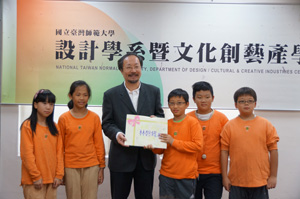 |
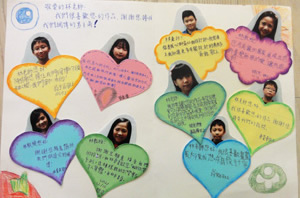 |
| Team mates presenting the card of gratitude |
The card of gratitude (words of gratitude) |
| |
|
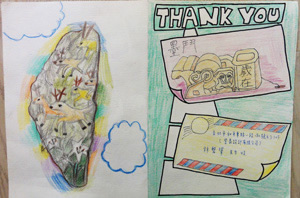 |
 |
| The card of gratitude (beautiful hand drawings) |
Lecture by Professor Lin I |
| |
|
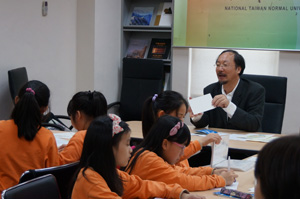 |
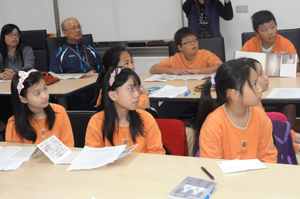 |
| Lecture by Professor Lin II |
Listening very carefully |
| |
|
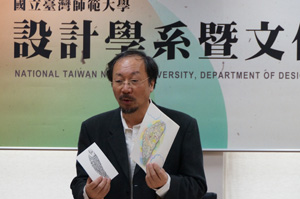 |
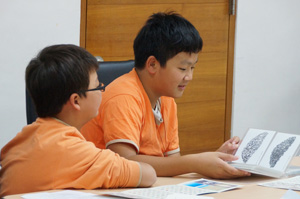 |
| Learning from the master |
Intrigued by the art works |
|
|
|
 Cultural literacy is like the DNA of design. Though somewhat hidden, it is the deciding factor of
Cultural literacy is like the DNA of design. Though somewhat hidden, it is the deciding factor of 






